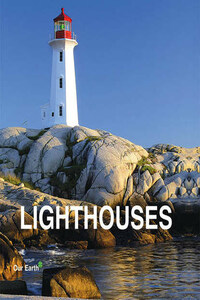Layout:
Baseline Co Ltd.
61A-63A Vo Van Tan Street,
4>th Floor
District 3, Ho Chi Minh City
Vietnam
© Parkstone Press International, New York, USA
© Confidential Concepts, Worldwide, USA
Image-Bar www.image-bar.com
All modification and reproduction rights reserved internationally. Unless otherwise stated, copyright for all artwork reproductions rests with the photographers who created them. Despite our research efforts, it was impossible to identify authorship rights in some cases. Please address any copyright claims to the publisher.
* * *
“The lighthouse was then a silvery, misty-looking tower with a yellow eye, that opened suddenly, and softly in the evening.” – Virginia Woolf, To the Lighthouse.
With the increase of technological, navigational mechanisms such as automated buoys in the 1980s, lighthouses are no longer solely depended upon for coastal protection. However, their historical presence must not be overlooked; these “beacons of light” have protected and marked our shores for centuries.
The first lighthouse, the Pharos of Alexandria, dates back to the beginning of the 3rd century B. C. E. and was considered one of the Seven Wonders of the Ancient World. This lighthouse was estimated to have led ships into Alexandria for more than 1,500 years. The Latin word “pharus” derives from the name of the island, Pharos, where it was situated. The use of the Latin root in several romance languages illustrates the importance of its presence in history. In addition to the architectural feat accomplished with the construction of the Pharos of Alexandria, the lighthouse served as propaganda for Ptolemy I, who was eager to impress travellers, thereby establishing himself as the cultural, economic and political power of the city.
During the expansion of the Roman Empire, several other lighthouses were constructed to mark military or legendary victories, such as the Tower of Hercules in Coruña, Spain (one of the oldest existing lighthouses in the world). However, after the fall of the Roman Empire, the construction of lighthouses virtually stopped and wasn’t revived until the 14>th century. During the 17>th century, many lighthouses in coastal European communities were overseen by monks in nearby monasteries. As seafaring and navigation became more advanced and prevalent, marine authorities were established to monitor the construction and maintenance of lighthouses. One of the most renowned authorities was the Trinity House in England, which built its first lighthouse in 1609 and went on to control lighthouse construction for all of England, Wales, the Channel Islands and Gibraltar.
Several different methods have been used to light these towers over time. In ancient times, they were lit by fires fuelled with coal or wood. From medieval times up until the proliferation of electricity in the 19>th century, various forms of lamps were used (often whale oil or kerosene) to keep the beacons bright. Lighthouse keepers traditionally lived on-site, monitoring naval traffic, sounding alarms to warn against storms and taking care of the overall maintenance of the lighthouse to ensure that it was always working properly. When lighthouses began to be automated around the 1960s, there was no longer a need for the keepers, and most lighthouses are now monitored by the local coast guard or port authority.
If these towers were once essential beacons on the shoreline, making visible the hazardous areas to prevent ships from encountering treacherous rocks and reefs, they have now also become aesthetic landmarks. These solitary lighthouses keep vigil in the night, watching over rocky crags and crashing waves like sentinels. In many coastal villages, the lighthouse has become the most iconic monument, drawing tourists and visitors who are curious about its historical significance and eager to take in the panoramic views from the top.
Ras Nungwi Light, 1926 (station established 1881).
Height: 14 m. Zanzibar. Focal plane: 18 m, one white flash every 5 seconds.
Port Shepstone Lighthouse, 1906 (imported from Great Britain).
Cast iron, height: 8 m. Port Shepstone, South Africa.
The lighthouse at Port Shepstone, named in honour of Sir Theophilus Shepstone, an admired South African statesman, was originally erected in 1895. At that time, it was a simple beacon made up of a lantern hoisted atop a laddered structure. This incarnation of the lighthouse was removed in 1905, and a cast iron tower topped with a radio beacon was built in its place in 1906. The current lighthouse has a white light that revolves and flashes once every six seconds. It is painted in unique black and white checkers, making it a whimsical addition to the landscape.
Ras Boujdour Lighthouse, 1903.
Masonry, height: 45 m. Cape Boujdour, Morocco.
Three white flashes every 15 seconds, range: 24 nautical miles.
Cape Spartel Lighthouse, 1864.
Masonry, height: 24 m. West of Tangier, Morocco.
Four white flashes every 20 seconds, range: 30 nautical miles.














